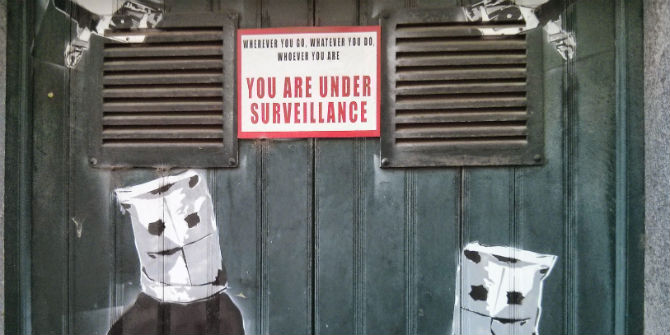 Reporters Without Borders (‘RSF’), along with Freedom House, IFEX and others, produce international league tables on press freedom. These rank each nation’s commitment to freedom of journalists and expression. Whilst experts occasionally question the methodological robustness of ‘Press Freedom Indices’ they are often seen as powerful tools in public advocacy and debate. This begs the question of what kind of media response this Press Freedom Index actually generates. In the wake of publication of RSF’s 2012-13 data, LSE’s Matilde Beccatti looks at the initial media coverage among journalists, bloggers and the twittersphere. What is the advocacy impact of the index?
Reporters Without Borders (‘RSF’), along with Freedom House, IFEX and others, produce international league tables on press freedom. These rank each nation’s commitment to freedom of journalists and expression. Whilst experts occasionally question the methodological robustness of ‘Press Freedom Indices’ they are often seen as powerful tools in public advocacy and debate. This begs the question of what kind of media response this Press Freedom Index actually generates. In the wake of publication of RSF’s 2012-13 data, LSE’s Matilde Beccatti looks at the initial media coverage among journalists, bloggers and the twittersphere. What is the advocacy impact of the index?
On January 31st press freedom watchdog Reporters Without Borders published its 2013 edition of the World Press Freedom Index[1]. The latest report introduces a global “indicator” of media freedom, which measures the worldwide level of freedom of information. The index then presents an evaluation of media freedom at the global as well as national level, and ranks countries based on relative degrees of media freedom.
Various media outlets, including newspapers, blogs and Twitter posts in English, French, Spanish and Italian, published reactions to the report during the days immediately after its release. Taking into consideration a sample of 46 articles and blog posts that look at the report from the most critical perspectives, it is possible to discern some of the main mass media resonances created by the report:
- Violence against journalists is newsworthy only for a small number of outlets: 4 articles emphasised RSF’s finding that 2012 was the deadliest year yet for journalists. 90 journalists, 6 media assistants and 47 netizens and citizen journalists were killed worldwide last year: The highest toll since Reporters Without Borders has kept track.
- 11 articles focused on the Arab region. Of note is a common observation that the fluctuations in rankings caused by the Arab Spring have now stabilized, and therefore “this year’s index is a better reflection of the attitudes and intentions of governments towards media freedom in the medium or long term”[2]. 9 newspapers saw this stabilization as a failure to live up the promises of freedom of expression raised during the Arab Spring. The protest-hit regions, in fact, were still ranked as the least free in the world. In particular, Syria was highlighted as the deadliest country for journalists in 2012. Media outlets noted that even neighbouring Lebanon, traditionally one of the top Arab countries for press freedom, has dropped eight places amidst the Syrian conflict, and media freedom remained “deplorable” in Tunisia and Egypt[3]. Yemen was also singled out, as there have been “no legislative changes”, and “journalists are still exposed to physical attacks, prosecution and even jail sentences”[4].
- League tables do offer a way of putting law reform on the public agenda. 8 media outlets noted that a number of longstanding democracies have dropped in the rankings after tightening press restrictions: Japan took a big fall of 31 places, amidst tight government restrictions on information about the Fukushima nuclear accident. The repression of student protests in Canada, called ‘Maple Spring’, accompanied that nation’s 10-spot drop. Despite 16 of its members still in the top 30 positions, European models of press freedom are said to be unraveling [5]. Greece dropped dramatically as journalists have been subjected to threats and violence from political extremists and police. Hungary continues to have repressive media laws and is censoring “government-critical content”. Italy has advanced in the ranking, but “defamation has yet to be decriminalized and state agencies make dangerous use of gag laws”[6].
- Experts question whether league tables might facilitate ‘naming and shaming’ by the media. 13 articles focus on the “fallers”, trying to explain the reason for their drops. The country that regressed the most according to the report is Mali, which fell 74 places. Mali was once a regional leader in terms of press freedom, but after the military coup in Bamako and the seizure of the north, many radio stations stopped broadcasting, journalists were physically attacked and state-owned media has been taken over by the army. Yet despite focusing on such “fallers”, explicit calls for change were lacking in mass media. These were only found in a 2 blog posts about Malaysia, 1 about Tanzania and 1 about Tunisia.
- However, it is not all about the negatives. Several pieces (8 articles) conclude with some words of optimism, reporting good news about countries where media freedom has ameliorated. One such country is Myanmar, which gained 18 spots following government reforms last year. In August, Myanmar announced the end of pre-publication censorship that was a hallmark of the decades of military rule that ceased in 2011. “There are no longer any journalists or cyber dissidents in the jails of the old military dictatorship”[7].
As stated, this post takes into consideration only a sub-sample of articles and blog posts that critically analyse the report. It is striking that the majority of media coverage observed during the course of this research have generally not responded critically to the report’s conclusions. In general, it seems that the use of league tables is an effective and simple way of gathering media attention. Yet most articles and commentaries, in fact, tend to only summarize the results without significantly analysing them, typically reporting only the number of places each country has risen and fallen in comparison to last year’s index. Though the report centers around the topic of media freedom, the media response seems surprisingly unconcerned about its conclusions. Even in countries were media freedom has diminished, only a few articles and blog posts have called for meaningful action.
An important goal of organisations like Reporters Without Borders is to raise awareness of constraints on freedom of expression. These rankings are a useful tool for indentifying major deficiencies in press freedom, but they are only the first step to progress. Based on the observed coverage, perhaps more effort can be done by media outlets in countries with stronger reputations for media freedom to direct attention to abuses in lower ranking countries in a way that can promote policy advocacy in those regions. Additionally, such a critical look at the rise and fall of media freedom can remind audiences that freedom of expression is fragile and should not be taken for granted. Whilst freedom can be cultivated, it can also easily be placed in danger, and citizens of all nations should seek to enable access to healthy and uninhibited information across all borders.
[1] “Press Freedom Index 2013 – Reporters Without Borders.” Press Freedom Index 2013 – Reporters Without Borders.
[2] Ibid.
[3] “Report: Arab Spring Not Bringing More Press Freedoms.” Voice of America (30 January 2013).
[4] “Press Freedom 2013: Mali Plummets following Turmoil.” Channel 4 News (30 January 2013).
[5] Press Freedom Index 2013 – Reporters Without Borders.” Press Freedom Index 2013 – Reporters Without Borders. N.p., n.d. Web.
[6] Ibid.
[7] Lalit Kjha, “Burma Shows Significant Improvement in Press Freedom: Report.” The Irrawaddy (30 January 2013).





